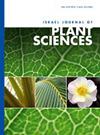Morphological and molecular diversity analysis vis-a-vis phylogenetic correlation among pomegranate (Punica granatum L.) varieties
IF 0.9
4区 生物学
Q4 PLANT SCIENCES
引用次数: 0
Abstract
Identification of different pomegranate (Punica granatum L.) genotypes using morphological descriptors and further substantiated through molecular means is essential for a breeding program. Characterization using molecular markers has an advantage over its morphological counterpart due to its low expense, quick and reliable results, and the requirement of less sophisticated equipment. In this study, eight different pomegranate cultivars were characterized based on their morphological and molecular characters in sub-tropical regions between 2018 and 2019. Morphological experiments were conducted in a randomized block design replicated thrice for each cultivar, whereas RAPD markers were employed for molecular studies. Principal component analysis revealed significant morphological variation (79.61%) among the cultivars. A high level of polymorphism, similar to PCA, was observed with RAPD analysis (80.49%). Some discrepancies between morphological and molecular results were noted in UPGMA cluster analysis. However, eight primers (total = 41) distinctively separated the Bhagwa variety from others, with the maximum similarity coefficient value (ca. 0.54) and superior fruit quality distinguished in PCA analysis with the maximum mean Euclidean distance (ca. 16). Hence, RAPD markers could be used along with morphological markers for a quick screening of germplasms in further crop improvement programs.石榴(Punica granatum L.)品种的形态和分子多样性分析与系统发育相关性研究
利用形态描述符鉴定不同的石榴(Punica granatum L.)基因型,并通过分子手段进一步证实其基因型,对育种计划至关重要。利用分子标记进行鉴定比形态学鉴定更有优势,因为其费用低、结果快速可靠,而且不需要复杂的设备。在本研究中,2018 年至 2019 年期间,在亚热带地区根据形态和分子特征对 8 个不同的石榴栽培品种进行了表征。形态学实验采用随机区组设计,每个栽培品种重复三次,分子研究则采用 RAPD 标记。主成分分析表明,各栽培品种之间存在明显的形态差异(79.61%)。RAPD 分析也观察到了与 PCA 相似的高水平多态性(80.49%)。在 UPGMA 聚类分析中,形态和分子结果之间存在一些差异。然而,有 8 个引物(共 41 个)将 Bhagwa 品种与其他品种明显区分开来,相似性系数最大(约 0.54),在 PCA 分析中,果实质量上乘,平均欧氏距离最大(约 16)。因此,在进一步的作物改良计划中,RAPD 标记可与形态标记一起用于种质的快速筛选。
本文章由计算机程序翻译,如有差异,请以英文原文为准。
求助全文
约1分钟内获得全文
求助全文
来源期刊

Israel Journal of Plant Sciences
生物-植物科学
CiteScore
1.90
自引率
0.00%
发文量
17
审稿时长
>12 weeks
期刊介绍:
The Israel Journal of Plant Sciences is an international journal of extensive scope that publishes special issues dealing with all aspects of plant sciences, including but not limited to: physiology, cell biology, development, botany, genetic
 求助内容:
求助内容: 应助结果提醒方式:
应助结果提醒方式:


